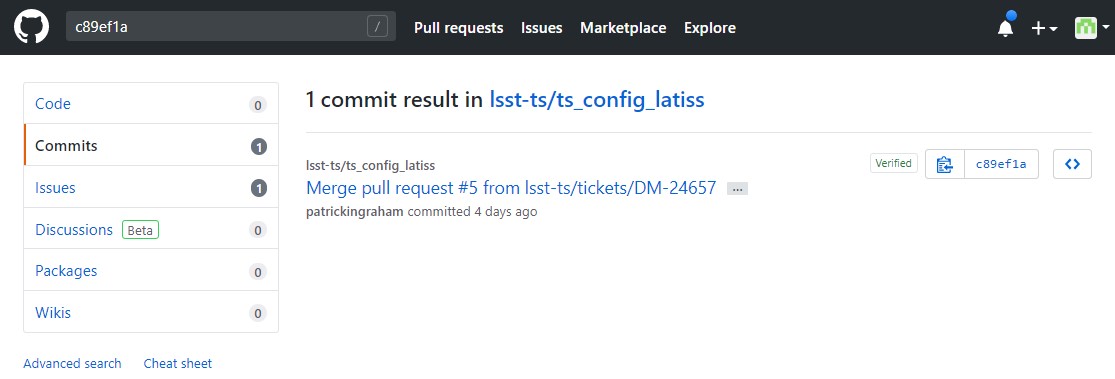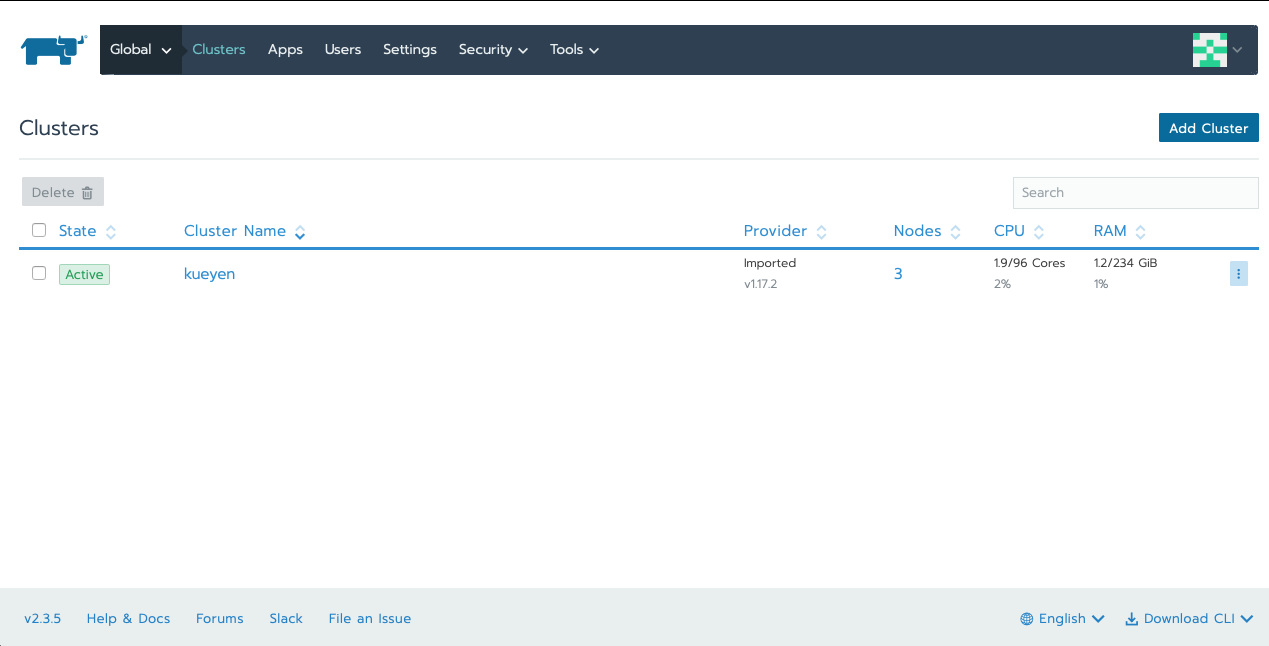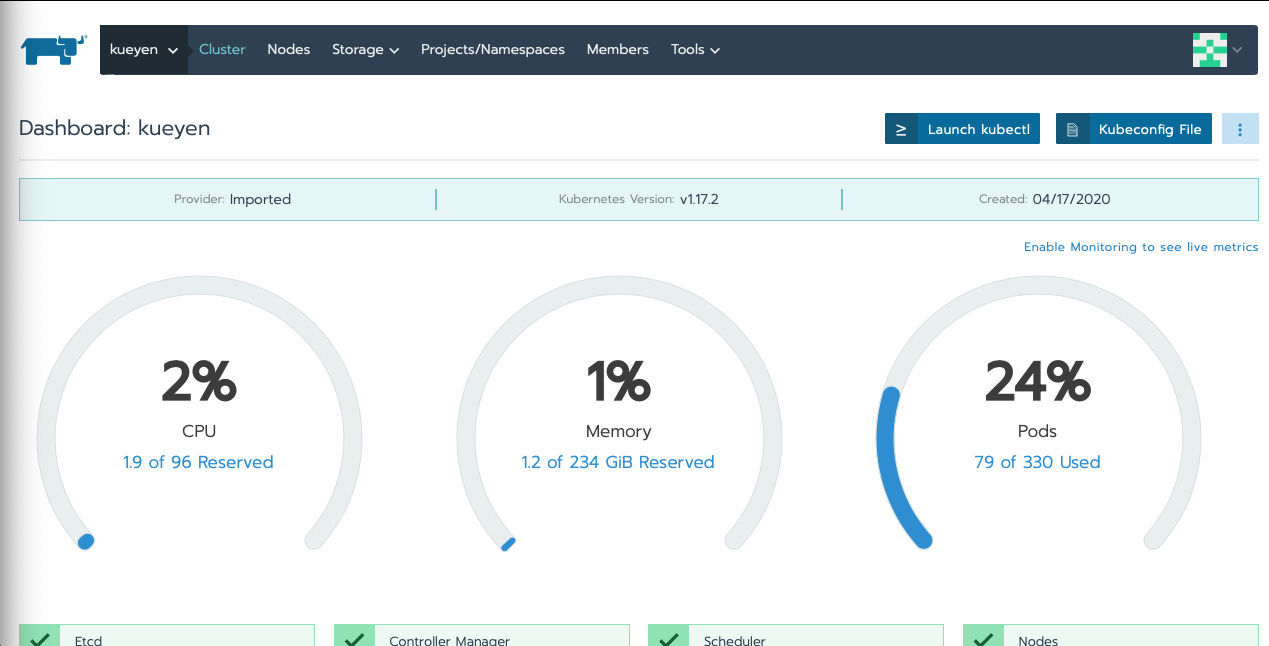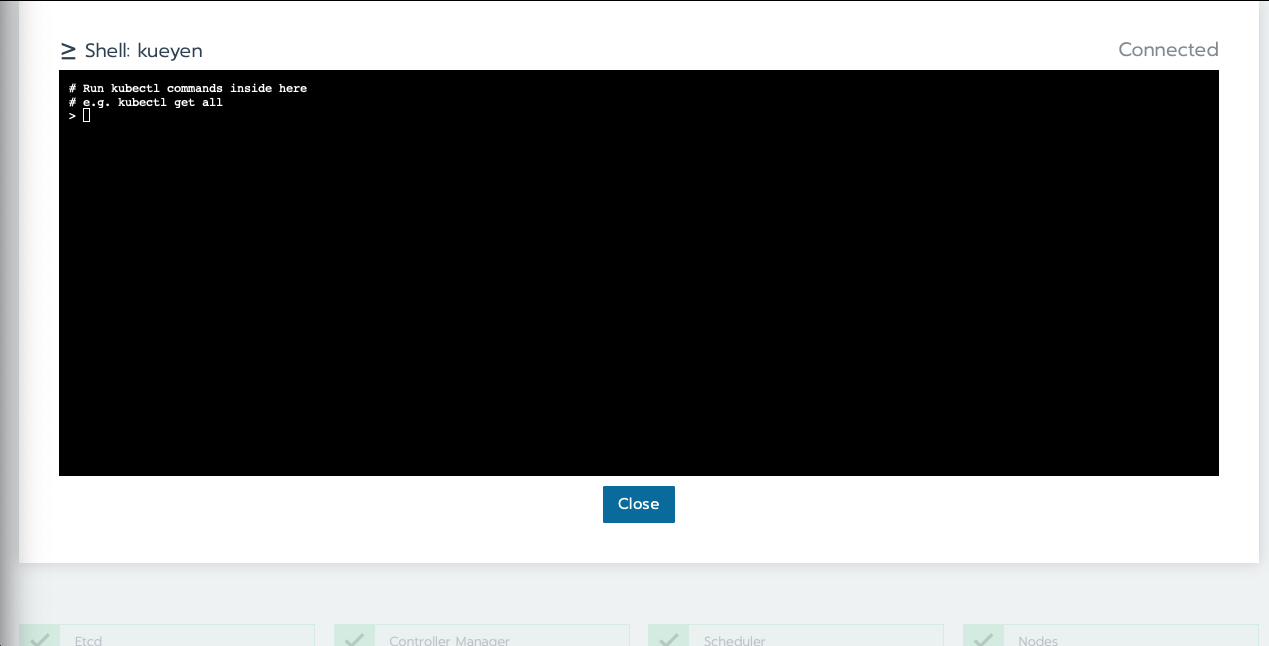Warning
This guide is written under the assumption that the configuration handling proposed in LCR-2269 is accepted. This includes the changes discussed in Proposal For Improvements section of tstn-017. The procedures in this documents are still under development. The functionality referenced here is not in place nor has it been agreed upon as the proper implementation.
For the time being, this document should be considered a proposed implementation. Upon completion of the LCR, tstn-017 will be deprecated and the applicable content will be moved here such that this becomes both a user and implementation guide.
Note
This manual shows users how to change, add, or revert configurations of all CSCs. This document is intended for operators of the Vera Rubin observatory control system. It consolidates information about how to handle CSC configuration and ancillary data. After reading this document users should know what to expect when interacting with system component’s configuration, how to select a configuration for a component and, be able to create and load new configurations.
1 Introduction¶
The Vera Rubin Observatory control system is highly distributed, containing multiple components that must operate in consonant. In order to achieve reliable operation it is fundamental to guarantee that observers must be able to, at any point, identify what set of configurations a component is using, what sets are available to be loaded, and how to load the configuration they choose. During commissioning and engineering runs, users will also be interested in building, validating and verifying new sets of configurations.
Although the configuration data structures (e.g. schemas) vary considerably between components, the process to update them is standardized. In some cases, the configuration may be a simple set of host name and port that the component connects to. In other cases, the configuration may require the calculation of complex lookup tables (e.g. M1M3 and M2) or model coefficients (e.g. pointing component). These may require on-sky time for acquiring the data, and complex software to analyze and derive the configuration products. All of this data needs to be associated with this configuration in a way that is easily accessible and traceable.
In this tech-note we discuss the basic organization of configurations and the operational procedures involved in handling CSC configuration. The document begins with the most simple case of bringing a CSC up with a specific configuration, and eventually details how to updating and testing newly defined configurations.
Most CSCs handle configuration in the same manner, however, there are a few exception to the rule, notably the Camera CSCs. These special cases are addressed in section-appendix-configuration-non-salObj.
For more technical details about how CSCs handle configuration, including the definition of configuration related topics published by the CSC, see tstn-017.
2 Configuration Repositories and Files¶
It is important to have the ability to modify configurations without re-deploying components, therefore, configuration files are stored in their own repositories and kept separated from the code. The configuration repository associated with each CSC is found in the configuration column of the Master CSC Table. Each of these configuration repositories are organized as follows:
A single configuration repository may host configurations for multiple CSCs.
CSC configurations are stored in folders with the CSC name.
Each CSC folder contains sub-folders corresponding to the versions of the CSC configuration (e.g.
v1,v2).A folder for a given version contains up to three different types of configuration files, all of which are yaml files. The three types of configuration files are detailed below and are listed in the order of which they are read:
- Initial Configuration:
_init.yaml. - This required file contains all values that are expected to be common to all sites and/or be relatively static in operations. This file may contain a complete set of parameters, but is only required to do so if no site-specific configuration file exists.
- Initial Configuration:
- Site-specific Configuration:
_summit.yaml,_ncsa.yaml,_base.yamletc. - This optional file contains contain site specific configuration parameters such as IP addresses and ports.
Many CSCs have site specific files.
Between this file and the
_init.yamlfile, the configuration must be fully defined
- This optional file contains contain site specific configuration parameters such as IP addresses and ports.
Many CSCs have site specific files.
Between this file and the
- Site-specific Configuration:
- Configuration overrides:
filename.yaml - These optional files, referred to as configuration overrides, are only to be used when the values declared in the previous files require changes. These files are loaded manually by the users as is demonstrated in the section-configuration-interaction.
- Configuration overrides:
If a value is specified in more than one of these files, the most recently seen value is used. This means that values in the site-specific (
_<site>.yaml) file override values in the initial file (_init.yaml). Also, values in the override file (filename.yaml) override values populated in the_init.yamland_<site>.yamlfiles.
For more technical details about how CSCs handle configurations, see tstn-017.
3 Configuration Interaction Use-Cases¶
Users will interact with configurations in multiple ways. In many cases, a user/operator will only need to change the configuration that is currently loaded and are not concerned with the contents of the configuration itself. In other cases, the user/operator will need to make a change to file, then immediately reload it. This section illustrates example use-cases for these types of scenarios.
3.1 Selecting the Default Configuration¶
In the high majority of cases, users will want to load the default configuration. The default configuration consists of parameters in the _init.yaml file and subsequently the _<site>.yaml, if it is present. These files are loaded automatically when performing state transitions using salobj or any higher-level software.
In most cases, the control packages contain high-level commands to enable all components under their control. An example of this is the ATCS. The following example enables all ATCS controlled components using their default configurations.
from lsst.ts.observatory.control import ATCS
atcs = ATCS()
await atcs.start_task
await atcs.enable()
If working with an individual CSC, which should be a special case, default CSC configurations are loaded by directly transitioning the CSC via:
from lsst.ts import salobj
domain = salobj.Domain()
atdome = salobj.Remote(domain, "ATDome")
await atdome.start_task()
# CSC needs to be in STANDBY state for this to work
await salobj.set_summary_state(atdome, salobj.State.ENABLED)
If these types of tasks are performed from the LOVE interface, then the same result occurs where the defaults are loaded automatically.
3.2 Discovering Available Override Configurations¶
The easiest way to get information from a CSC programmatically is by using a Jupyter notebook server. From a notebook, observers, developers and power users can easily interact with the system through Python.
In order to know which configurations are available for a specific CSC, users can read the configurationsAvailable event.
This is done using a salobj.Remote class.
from lsst.ts import salobj
domain = salobj.Domain()
atdome = salobj.Remote(domain, "ATDome")
await atdome.start_task()
config_available = await atdome.evt_configurationsAvailable.aget(timeout=5.)
# This will print the available filenames.
print(config_available.configurations)
# This will print the git hash of the loaded configuration repository
print(config_available.version)
Often, this can also be accomplished using a high-level class that is designed to interact with a group of CSCs.
from lsst.ts.observatory.control import ATCS
atcs = ATCS()
await atcs.start_task
config_available = await atcs.rem.atdome.evt_configurationsAvailable.aget(timeout=5.)
# This will print the available filenames.
print(config_available.configurations)
# This will print the git hash of the loaded configuration repository
print(config_available.version)
It is also possible to check this information by querying the EFD or through the CSC summary information interface on LOVE. Examples of how to do this using the LOVE interface will be added when the functionality is ready.
3.3 Selecting an Override Configuration¶
Selecting non-default configurations via control packages is also possible. These are generally used for circumstances where customization is required, or a fallback from standard functionality is necessary. For example, if the look-up tables in the default configuration for the ATAOS are causing problems, then we can use this procedure to override the defaults by specifying a configuration file that contains the values from the previous look-up table.
When enabling components using the ATCS class, a dictionary is used to provide the appropriate configuration override files for each component that needs a non-default configuration.
This example assumes the component of interest is already in the STANDBY state.
from lsst.ts.observatory.control import ATCS
atcs = ATCS()
await atcs.start_task
# ATAOS must be in STANDBY state for this to work. All other CSCs will
# use their default configurations
await atcs.enable(configurationOverride={'ATAOS': 'summit_constant_hex.yaml'})
Examples of how to do this using the LOVE interface will be added soon.
If working with an individual CSC, which should be a special case, the salobj.Remotes class may be more appropriate:
from lsst.ts import salobj
d = salobj.Domain()
atdome = salobj.Remote(d, "ATDome")
await atdome.start_task()
await salobj.set_summary_state(
atdome, salobj.State.ENABLED, configurationOverride="simple_algorithm.yaml"
)
4 Modifying or Creating a New Configuration¶
The process to derive new configuration parameters varies considerably from component to component. In some cases, the configuration is simple enough that a change may involve simply replacing an IP or hostname value, a routine filter swap on an instrument or updating the limits to an axis range due to some evolving condition. On the other hand, deriving new parameters may involve generating complex LUTs that may require on sky observations and detailed data analysis.
Following is a detail of each step of the process to generate a new configuration and update it for CSCs written in salobj. For other components, see the exception section below.
Create a Jira ticket to track the work being done (e.g. DM-12345). If details or discussions are needed they can done using the Jira ticket itself. Then clone the configuration repository and create a new branch corresponding to the Jira ticket number.
git clone git@github.com:lsst-ts/ts_config_attcs.git git checkout -b tickets/DM-12345
Execute the work needed to derive the new configuration parameter(s).
As mentioned above, in some cases, the process may be straightforward, consisting simply of replacing the values of a set of parameters with given values (e.g., swapping filters). In these cases, this step will be simply verifying any required work was performed and continuing to the next step. Jira should be used to track those activities.
The Jira ticket should also be used to track the work done on those cases where a more involved analysis is required, e.g., in-dome and/or on-sky data acquisition, EFD queries, data processing etc. Any ancillary software or data product required during this process should be properly managed using git. When working with Telescope and Site components, any software required during this process should be stored in a git repository in T&S GitHub organization, and should follow the standard T&S development workflow guidelines. This includes, but is not limited to, EFD queries, Jupyter notebooks, other data analysis routines (regardless of the programming language) and so on. The preferred location for storing Jupyter notebooks is the ts_notebooks repository. If the procedure to generate the new configuration requires detailed explanation, a tech-note in tstn repository can be created and linked to the ticket.
Any intermediate data product(s) generated in the process should also be stored in the git Large File Storage or, if size permits, with the software repository itself.
Edit/Add/Replace the configuration file(s) in the CSC’s configuration directory.
- If editing the
_init.yamlor a_<site>.yamlfile, the filename must remain unchanged. - If editing or adding an configuration override file, ideally the name of the file should reflect the purpose of change; dates can also be used as well. Old configuration files can be kept in the repo if they still represent valid configurations. Otherwise, they should be removed. Note, though, that they will still remain available on previous commits in the git repo, enabling historical comparison.
- If editing the
Fill out the required metadata at the top of the file detailing where any auxiliary data may be stored, the Jira ticket number used to create the file, and the reason for creating the configuration, such as in this example.
If you have an environment to do so, such as the standard T&S development container, run the unit tests in the package locally.
Add, commit and push the changes, with a commit message.
git commit -am "Add new LUTs for ATAOS (file 20200512-configuration.yaml) based on data taken on 20200512. Check DM-12345 for more information." git push
Verify the continuous integration tests pass. If they don’t, fix the issue and repeat the previous step.
Test the new configuration on the CSC. If this requires in-dome or on-sky testing, then create an annotated alpha release tag. Then make sure the test is properly documented in a technote and/or Jira ticket. To make the configuration available on a running CSC check 4.3 On-the-Fly Configuration Changes.
Create pull request(s) (PRs) to have the files reviewed
You must create PRs for all repositories that were modified during the process, including, but not limited to, the configuration repository, ancillary software and documentation.
Once the PRs are reviewed and approved, the files can be merged and subsequently tagged. The new configuration then becomes official and will be deployed as part of the standard deployment process.
4.1 Exceptions¶
TBR.
4.2 Finding and Using a Previously Used Configuration¶
In the future, one may want to verify which configuration was being used for a given observation and possibly load the exact same configuration.
Because we often use generic filenames (e.g. simple_algorithm.yaml), and file contents can change with time, creating a robust version controlled system must go beyond simply changing filenames.
For this reason, additional metadata is associated with each configuration, notably the url and version parameters in both the configurationsAvailable and configurationApplied events.
These parameters are key to ensuring that each configuration is unique, and is traceable to their filename and contents.
The url parameter simply contains a URL indicating how the CSC connects to its settings (meaning a link to the repository).
The version parameter is more complicated.
For all CSCs (except possibly the cameras), the version parameter is a branch description[1] which is automatically generated and populated by the CSCs.
This is what is output by running the following command in a configuration repository (e.g. ts_config_latiss):
git describe --all --long --always --dirty --broken
| [1] | The option --broken was introduced in git 2.13.7 |
An example output is, heads/develop-0-gc89ef1a.
The repository branch (or tag) name forms the first part of the branch description.
This first part contain individual identifiers and can change rapidly.
It may take any form necessary to convey the appropriate information.
The last 7 characters (c89ef1a) is the hash of the commit of repository, so all configuration files in that repo correspond to the same hash.
Users can find this commit by navigating to the repository on github, searching for the commit hash, then
clicking on the “commits” section of the search results, as shown in the screenshot below.

Figure 1 Using the version output in the configurationApplied event, it is possible to traceback the repo to the configuration that was loaded.
Once we have identified the hash of the commit file we want to reload, we can do that without having to make any changes to the currently deployed ts_config package.
If we simply want to use the default site-specific configuration for a given CSC, we can specify the commit hash with a preceding colon (:) as follows:
from lsst.ts.observatory.control import ATCS
atcs = ATCS()
await atcs.start_task
# ATAOS must be in STANDBY state for this to work. All other CSCs will
# use their default configurations
await atcs.enable(configurationOverride={'ATAOS': ':c89ef1a'})
If we also want to specify an override file then we insert the filename before the colon (:) as shown below:
await atcs.enable(configurationOverride={'ATAOS': 'simple_algorithm.yaml:c89ef1a'})
4.3 On-the-Fly Configuration Changes¶
During the process of creating a new configuration (4 Modifying or Creating a New Configuration) or during a commissioning/engineering run, it may be necessary to make a new configuration available to a running CSC for testing without rebuilding/re-deploying the component. In these cases, the user should also create a Jira ticket (or work out of an existing ticket) to document the occurrence.
Following are the steps to make a new configuration available to a running CSC:
If the configuration is not already created and pushed to GitHub, follow steps 1 to 8 in 4 Modifying or Creating a New Configuration.
Create an annotated tag alpha tag following semantic versioning. The tag must be created to ensure the heritage is not lost in a forced commit to the branch
git tag -a v1.4.0.alpha.1 -m "Updated focus values based on on-sky tests"Make sure the CSC in in
STANDBYstate, which can be accomplished using the following command.await salobj.set_summary_state(ataos, salobj.State.STANDBY)
Login to the where the CSC is running. The procedure will vary depending on how the CSC is deployed. Most Telescope and Site components are deployed on containers using Kubernetes (k8s). For CSCs that are not running on a container, you should be able to login to the host machine with
sshand continue with the procedure (go to step 3). A provisional list of IPs can be found in confluence <https://confluence.lsstcorp.org/x/qw6SBg>. For details about the deployment system see the deployment documentation.The procedure to access containerized components is as follows:
Log in to the rancher service at https://rancher.ls.lsst.org. You will need special authorization to acquire an account on that service.
Warning
This service is responsible for managing the deployment of the entire system. Make sure you follow the procedure exactly. If you are in doubt about an operation make sure you verify it with knowledgeable personnel.
Once logged in, you will be presented with the list of available k8s clusters.

Figure 2 List of Kubernetes clusters. At the time of this writing, the only cluster available was kueyen, the commissioning cluster at the base facility in Chile.
Click on the name of the cluster where the CSC you want to modify is running. If it is a summit operation, the name of the cluster will be
andes. After selecting the cluster, you will be redirected to the cluster dashboard.On the top right corner of the cluster dashboard, there is a button with
Launch kubectl. This will open an interactive session on you browser that will allow you to interact with the k8s cluster you selected. If you are knowledgeable about k8s you can also download theKubeconfig fileand login to the cluster from your own computer.Warning
Do not download the
Kubeconfig fileunless you really know what you are doing. This file contains access and credential information that would allow users direct access to the k8s cluster.Once you select
Launch kubectlyou will be redirected to a Shell connected directly to the selected k8s cluster.Use the following command to discover the container running the CSC :
kubectl get pods -n cscsThis will list all the CSCs “pods” which are, basically, the running containers. The name of the CSC will be part of the pod name and should be easy to identify.
Connect to the running pod:
kubectl exec -it -n cscs <pod-name> -- /bin/bashMake sure to replace
<pod-name>with the name of the pod for that CSC.
Once inside the CSC host, go to the location where the configuration is installed. This information can be found in the CSC documentation or in the deployment documentation. You should be able to use regular linux command line commands (e.g.
lsandcd).Once in the cloned configuration package, update the git repository and checkout the tag with the new configuration:
git fetch --all git checkout tags/v1.4.0.alpha.1
You should see the new tag be pulled and git will tell you that you’ve changed tags/branches.
Now re-enable the component to load the new configuration.
If the
_init.yamlor_<site>.yamlfile was modified then use the following:await salobj.set_summary_state(ataos, salobj.State.ENABLED)
If an override configuration was modified/added, then you must specify it using the
configurationOverridekeywordawait salobj.set_summary_state(ataos, salobj.State.ENABLED, configurationOverride='summit_constant_hex')
The version attribute in the configurationsAvailable event would reflect that change with something like:
version: heads/tags/v1.4.0.alpha.1-g79e2257
Note that it would be possible to track the configuration in the future by using the commit hash (g79e2257).
4.4 In-line changes¶
During commissioning, we anticipate that there will be situations where quick configuration changes need to be implemented and tested. In these cases, working out of a local branch and going over the 4.3 On-the-Fly Configuration Changes process may result in the loss of on-sky time. To ensure the work/changes is tracked it is still recommended that the user create a Jira ticket (or work out of an existing ticket) to document the occurrence. Then, instead of checking out the repository locally, the user can work out of the deployed CSC configuration directly in the host.
Warning
Users cannot push changes from inside a component and therefore this method will result in a loss of information and traceability. Therefore, this procedure should be reserved only for critical situations.
To do this, perform the following procedure:
Verify (or transition) the CSC in in
STANDBYstate.await salobj.set_summary_state(ataos, salobj.State.STANDBY)
Login to the where the CSC is running. The procedure will vary depending on how the CSC is deployed. For containerized components, you can find details on how to do that in the deployment documentation.
Once inside the CSC host, go to the location where the configuration is installed. This information can be found in the CSC documentation or in the deployment documentation.
Create a local branch to work on that corresponds to the Jira ticket mentioned above.
git checkout tickets/DM-12345Use the available text editors (
vimandemacsare usually made available) to edit the configurations.Once the configurations are edited and saved, re-enable the component.
await salobj.set_summary_state(ataos, salobj.State.ENABLED)
Transient filenames with Jira ticket numbers may be used for developing new configurations. They should be moved to a more purpose-oriented filename at the earliest opportunity.
As stated in the warning above, these changes cannot be pushed from inside a component and therefore the changes made will result in a loss of information and traceability.
When you connect to the computer running a CSC and edit the configuration directly, the version parameter reflects that change with something like:
version: heads/tickets/DM-12345-0-g79e2257-dirty
When this happens, it prevents us from precisely identifying what configuration was used. In this case, the preferred solution is to use 4.3 On-the-Fly Configuration Changes to ensure traceability is not lost, at the expense of a couple extra minutes.
4.5 Exceptions¶
The following require different procedures to create/modify a configuration
5 Appendix I: Creating Configurations for non-salObj CSCs¶
This appendix details the require procedures to produce configuration files for specific CSCs that do not follow the procedure in this document.
5.1 Pointing Component¶
The pointing component has a configuration file that resides with the code base which, in itself, also defines a couple different files (e.g. pointing model).
Nevertheless, the CSC is not developed to be a configurable CSC, meaning it does not accept a configurationOverride value to switch between different configurations and does not output the required events.
The CSC is being developed by Observatory Sciences using C++.
Important
PROCEDURE TO BE ADDED
5.2 ATMCS and ATPneumatics¶
Important
PROCEDURE TO BE ADDED
5.3 Non-Configurable CSCs¶
Some CSCs will not be configurable at all.
Examples are sparse in our current architecture but, the from Salobj point of view, a CSC can be developed on top of a BaseCSC which makes it a non-configurable component.
Non-configurable CSCs will have no data in the configuration column of the Master CSC Table.
A non-configurable CSC will ignore the configurationOverride parameter of the start command, as it has no meaning.
Likewise these CSCs will not output any of the configuration-related events.
References

